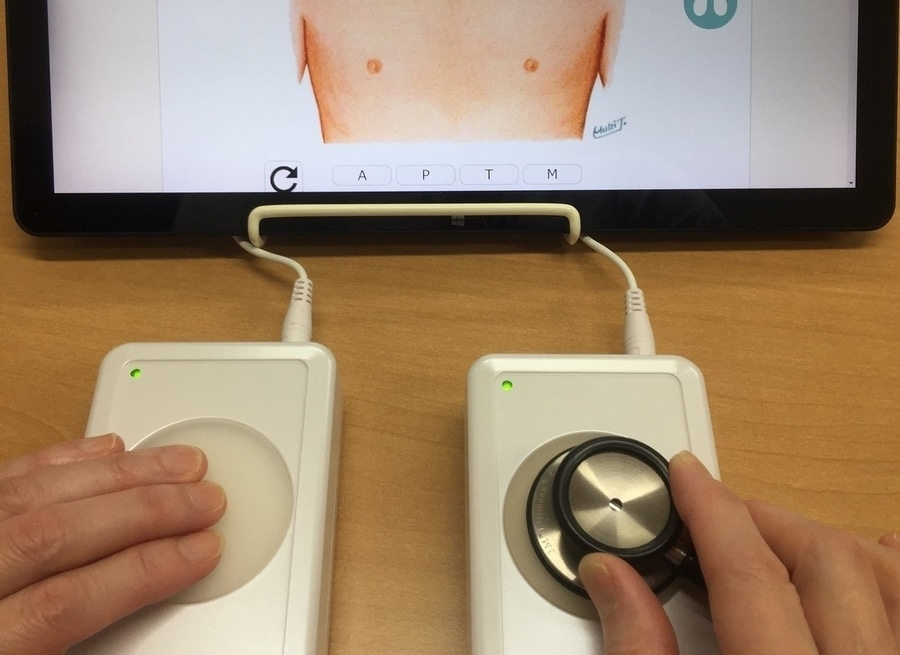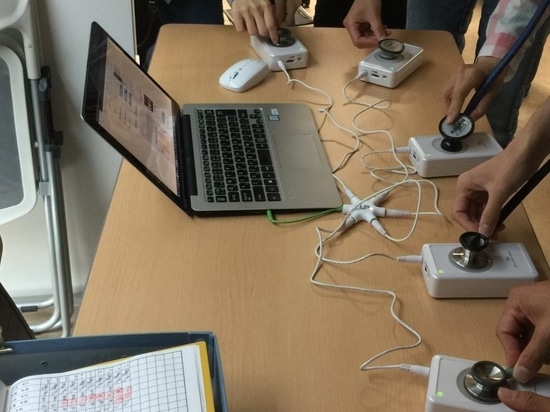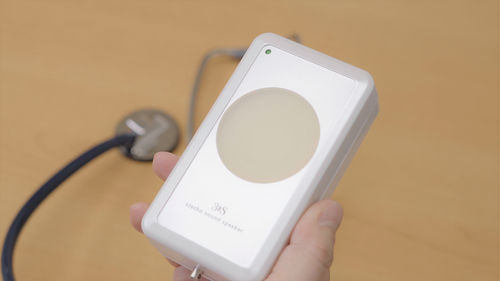
#Product Trends
An Auscultation Speaker and its Sound-Library for Students Working From Home
The Japanese company Telemedica developed the Kikuzo auscultation speaker designed for training, that can be used to listen to real heart sounds and murmurs with your own stethoscope anywhere, anytime.
The device is particularly useful since the Covid-19 pandemic forced students to train and take exams from home. We spoke with Kikuzo CEO Kiyoshi Fujiki.
MedicalExpo e-magazine: Can you tell us about the Kikuzo speaker?
Kiyoshi Fujiki: The Kikuzo speaker is very simple to use. You only need to connect the Kikuzo speaker to a PC, tablet or smartphone with a stereo cable and access the Kikuzo website or application through the internet. You can then place your own stethoscope directly on the round silicon diaphragm of the Kikuzo speaker and start listening to real heart sounds and murmurs that are stored on the website/application. In the website’s library section, all types of heart and lung sounds are stored and available for listening along with explanations about the body area. Kikuzo plays only the same band as the biological frequency, so it doesn’t include the electrical sounds that come through the speaker and the electrical device that is plugged into it. You can adjust the volume and even feel the thrill.
MedicalExpo e-magazine: What are the main innovative aspects of this speaker?
Kiyoshi Fujiki: One of the best advantages of this speaker is that it is very light and portable. So you can carry it and bring it anywhere, which is particularly interesting for training. In Japan, traditional training is carried out by using mannequins in university training facilities. However, mannequins weigh between tens and hundreds of kilograms and are often sold for several thousand to several tens of thousands of dollars. And anytime there is a practical exam, each medical school needs several sets of mannequins. Therefore, it is often difficult for universities to prepare mannequins.
The Kikuzo speaker has improved all of these problems. It weighs only 0.2 kg and costs under $2,000 per unit. This is why it has spread so widely in Japan since its creation in 2017 and especially since the Covid-19 pandemic. Hearing the sounds using your stethoscope on the Kikuzo speaker is not different from hearing the sounds of humans, because Kikuzo offers all the different types of sounds and also a very good quality of sound since it only plays the biological sounds and not the electrical ones coming from the devices.
MedicalExpo e-magazine: The device still doesn’t have the shape of a human body. Could this aspect pose a problem for training?
Kiyoshi Fujiki: In the beginning, the fact that the Kikuzo device doesn’t have the shape of a human body was cast as a negative aspect by medical training facilities. But this aspect has dramatically changed with the Covid-19 pandemic. The fact that Kikuzo is very light and compact and can be brought anywhere anytime became a huge advantage since students couldn’t go to the university training facilities anymore. Physical training sessions with mannequin simulators couldn’t be used online so the Kikuzo device was an ideal solution for bringing online training home. Other competitors did not choose to manufacture products like Kikuzo and we quickly had many demands for our device so that’s why we were able to spread all over Japan in a very short period of time.
MedicalExpo e-magazine: Telemedica is also working on a new application for auscultation training to use with the Kikuzo speaker.
Kiyoshi Fujiki: Yes students still connect the Kikuzo speaker to their PC or smartphone. They go to the app and they can see the image of a human torso. They can move the cursor on different parts of the torso and listen, with the Kikuzo speaker and their stethoscope, to the real sounds associated with the area or with some pathologies affecting this particular area, such as aortic stenosis or mitral regurgitation.
It helps learn both auscultation sounds and areas. There are other features such as changing the heart rate or turning on the lung sounds. Additionally, by using two Kikuzo speakers at the same time, students can hear the sounds and feel the pulse palpation like a patient. When you listen to the heart sounds on Kikuzo, you always feel the pulse palpation at the same time, so it is a great innovation to make this aspect available online.
The Kikuzo app also offers a series of quizzes for medical students and colleges. Students can compare normal and abnormal sounds, such as for example the lung sounds of patients suffering from lung cancer and the lung sounds of healthy patients. Recently, Kikuzo also recorded the lung sounds of actual Covid-19 patients and stored them on their website.
MedicalExpo e-magazine: Are you working on possible developments for the Kikuzo device?
Kiyoshi Fujiki: The Kikuzo speaker is currently only for medical education but in the future, we are looking into expanding it to the telemedicine field. Our strategy is to provide education for the telemedicine field. Kikuzo’s number one customers are universities, medical colleges and medical training facilities. We started extending our products to foreign countries last year, such as China, Korea and Taiwan. We are receiving more inquiries from European companies, as well as many countries in North America, South America and Russia.






